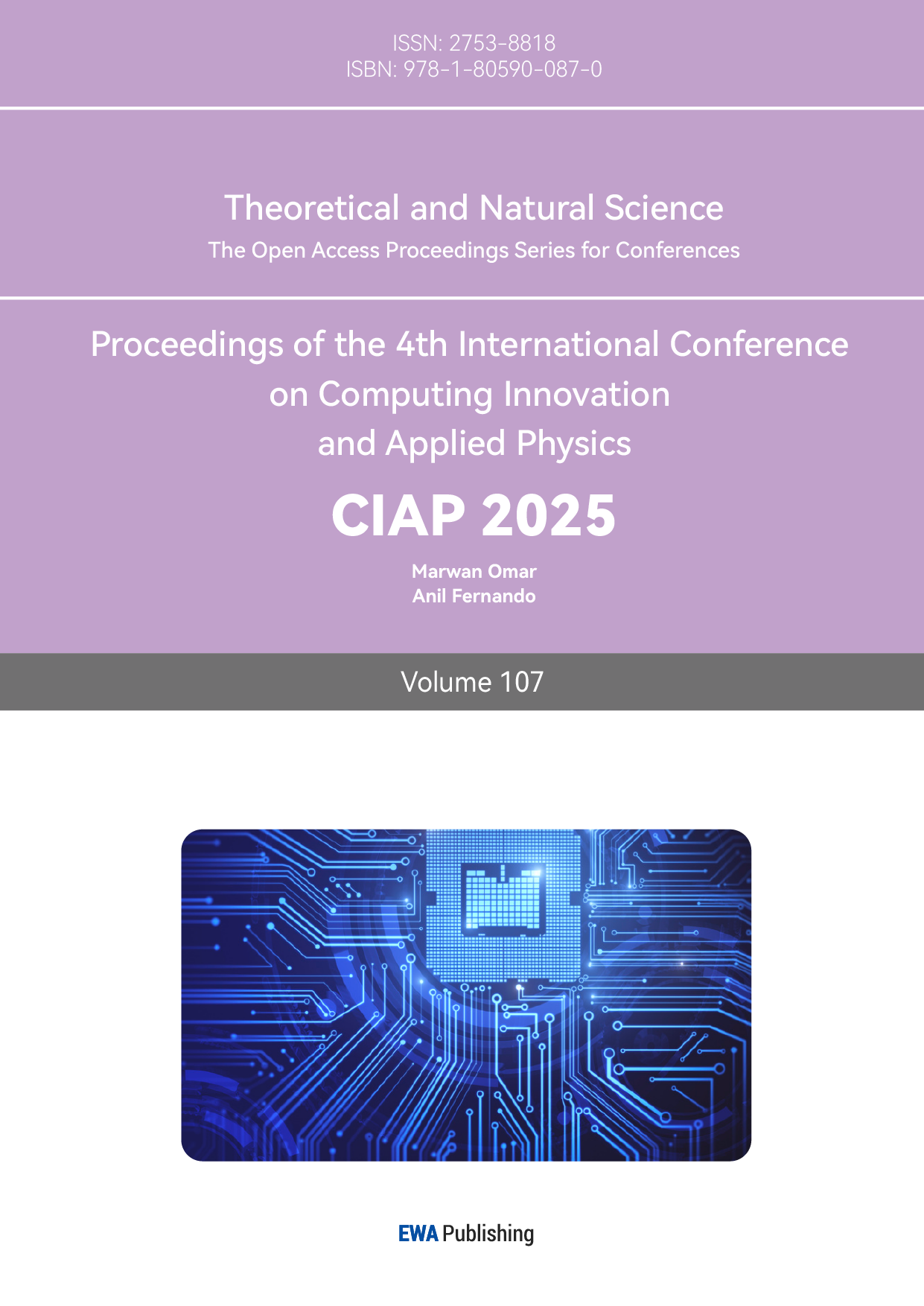1. Introduction
Many exosolar planets were observed with highly close orbit periods to their host star within days, but size compared to gas giants, so-called “Hot Jupiters.” The history of these types of planets could be traced back to the first exoplanet ever discovered near a G-typed, sun-like star, 51 Pegasi [1], astonishing astronomers at the time with unexpected properties [2]. Nevertheless, HJs are the most accessible planets to be found using the transiting method because their effect on the loss of flux to their host star is significant. These exotic exoplanets left doubts about their formation as they contradicted the protoplanetary disk theory, the mainstream explanation of planetary system formation.
However, HJs have conditions for observing stellar dissipation. In many short-period planetary systems, stellar tidal dissipation eventually leads to orbital migration toward its host star [3-6]. First, the planet’s rotational and orbital orbit would be synchronized, leading to a zero obliquity (rotational and orbital angular momentum vector alignment) orbit. This process would then cause the host star’s stellar period to be synchronized and drive the stellar obliquity to zero [5]. When the total angular momentum L is less than a critical value Lc, the planetary orbit would spiral towards the host star, increasing its rotational energy [3-6]. This process theoretically would lead to the engulfment of the planet [3,5].
This process of orbital decay is subtle, and the timescale of whether the process would occur under many circumstances is unknown. Previous studies have addressed stellar age [3,5], magnetic braking of tidal evolution [7], and orbital properties [8,9] that will play a role in determining orbital decay signs. Previous works also indicated that the suggestion of orbital decay-like might be an illusion of the Romer effect causing radial velocity change in planetary systems [10] or apsidal precession in eccentric orbits (however, eccentric orbits rarely exist among HJs since they are positioned in close orbit to its host star) Currently, the only HJ that designates clear implications of orbital migration due to stellar dissipation is WASP-12b [11], where previous studies [12] imported the quadratic trend of decreasing orbital period. Later, Patra et al. [13] presented more transiting data agreeing with the quadratic trend but left the doubt that these signs could be caused by apsidal precession. However, later publications ruled out the possibility of orbital decay suggestions caused by a potential eccentric orbit [14]. They confirmed quadratic signs were caused by orbital decay with stellar dissipation rate Q* 1.8*10^5 and orbital period decreasing rate 29 ± 2 ms yr-1.[10]
Since the debut of TESS, Researchers have obtained more recent and accurate data than those observed in ground-based telescopes. By programming with TESS data, we can gain more data to analyze any possible orbital decay signs and confirm indications of orbital decay with thorough and conclusive evidence with TESS scanning of sectors 71 and 72.
This paper aims to examine the newest TESS data of WASP-12b to observe whether the transit time deviation follows the detected appearance of a quadratic trend. Furthermore, we will be perceiving evidence of other possible candidates of orbital decaying Hot Jupiters for any prominent indication.
This paper is organized as follows. Section 2 describes the selection of possible candidates for Hot Jupiters, which we will examine in the following sections. Section 3 provides the technique we used to determine the acceptance of orbital decay, including any equations and programming skills we operate to proceed with the observation. Section 4 presents the data from TESS of WASP-12b to address the known parabolic trend and examine the other four candidates, WASP-4b, 19b, 114b, and KELT-16b. We will also analyze these data and provide necessary factors such as possible decay and minimum stellar tidal dissipation rates. Section 5 summarizes our results and gives possible direction for further research.
2. Target selection
To search for the newest evidence of orbital decay, we have to choose the Hot Jupiters with as short periods as possible, so we have targeted five hot Jupiters with orbital periods of around one day, which is more likely to happen orbital decay since they are near to their host star. The host stars of hot Jupiters we have chosen are WASP-12, WASP-4, WASP-19, WASP-114, and KELT-16, in which the WASP-12 had confirmed its orbit is decaying with strong evidence; the rest of the hot Jupiters still requires further confirmation.
Given that the orbital decay of WASP-12 and its hot Jupiter has already been confirmed, our primary mission is to utilize recent data from the TESS mission to validate the conclusion further. However, for the other four hot Jupiters, it is necessary to compare data from previous scholars with recent TESS observations to get the newest evidence of orbital decay for these four targets.
3. Method
3.1. Data selection
To get the data that shows strong evidence of orbital decay, we have to choose data across as much time as possible since data with significant time separation will show more obvious shirking in the orbital period.
We will introduce the period, time that takes the measurement, and the uncertainty data of 5 hot Jupiters from papers by other scholars and the recent data from the TESS mission through Lightkurve, which benefits the comparison between the time scale across tens of years.
3.2. Data processing
The data from the lightkurve of the TESS mission only gives the flux data of the targeting stellar system, so using the transit method would be efficient to get the orbital number and the time to finish the orbit. Whenever the hot jupiters finish 1 orbit, there will be a dip shown in the flux data, and this will be counted in the orbit number and arrayed these data by the time that finished the orbit in BJD. Since our subject is mainly focused on the newest evidence provided by the TESS mission, we subtract the time that starts the TESS mission from when it finishes the orbit in BJD and round it to the nearest integer to get the list of orbit numbers.
By combining the data from previous scholars with the newest observations from the TESS mission on the timing of orbital periods for the target hot Jupiters, we first fit the data with the linear best-fit curve, which allows us to get the residuals between the scattered data points and the best-fit curve, this could be used to prove whether there is a trend of orbital decay over time. Then, the quadratic best-fit curve is applied to testify whether the precision of equipment causes the data presence of any outliers to affect the result.
3.3. Calculation
3.3.1. Modified Tidal Quality Factor
The Modified Tidal Quality Factor is an essential factor that tells the shrinking rate of the orbiting period and the orbit when the orbit is decaying, and the calculation of the change of the orbital period over time (equation 1) and the Modified Tidal Quality Factor (equation 2) follows the following formula [15].
\( T(n)={T_{0}}+P*n+\frac{1}{2}P*\dot{P}*{n^{2}} \) (1)
\( {Q_{s}} \prime =-\frac{27}{2}π(\frac{{M_{p}}}{{M_{s}}}){(\frac{a}{{R_{s}}})^{-5}}{\dot{P}^{-1}} \) (2)
The function \( T(n) \) (equation 1) describes the change of the period of the targeting planets with a constant rate, the \( \dot{P} \) (equation 1-2) stands for the change of the orbital period derivative to the time, the P is the period of the targeting hot Jupiter.
The Mp/Ms is the mass ratio between the star and the planet, and the a/Rs is the ratio between the semi-major axis and the stellar radius. If the orbits of hot Jupiter are shrinking, the theoretical value of the tidal decay factor is supposed to be near the value of 106.
3.3.2. Chi-Square and Degree of Freedom
Introducing the statistics method of Chi-Square could be used in the quadratic best-fit curve to examine the precision and validity of the data from the other scholars and the TESS mission; the calculation of theoretically Chi-Square follows the following formula (equation 3).
\( {Χ^{2}}=\sum {(\frac{{O_{i}}-{E_{i}}}{{σ_{i}}})^{2}} \) (3)
The \( {Χ^{2}} \) stands for the Chi-Square, the \( {O_{i}} \) is the observed values, the \( {E_{i}} \) is the calculated values by the best-fit curve, and the \( {σ_{i}} \) is the uncertainties from the observation.
Moreover, the statistics term Degree of Freedom is the extent of freely selecting data when fitting the model, so when fitting the quadratic best-fit curve, the degree of freedom is the amount of data minus the number of parameters, which is 2.
Comparing the value of the Chi-Square and the Degree of Freedom under a quadratic best-fit curve can show whether the model fits well or not; if two values are close or equal, then it can tell the data from other scholars and TESS mission has quadratic decreasing trends, which means the orbital period is decaying. For all of the targeting hot Jupiters, we processed the outliers in data and ensured the chi-square and degree of freedom values were close.
4. Observations and data analysis
4.1. WASP-12b
4.1.1. WASP-12b data analysis
WASP-12b is a 1.4 to 1.5 Jupiter mass planet with a 1.09-day orbit around its host star that is believed to be a late-F, main sequence star. WASP-12b was discovered in 2008 using transiting and Doppler radial velocity method [11]. The previous analysis of WASP-12b indicated its parabolic-shaped transit time deviation [13]. The possibility of it being caused by potential apsidal precession was mentioned in earlier research and was ruled out along with the Romer effect [10,13]. Researchers concluded that WASP-12b is the first extrasolar planet that has shown clear signs of orbital decay by stellar dissipation with a decay rate of 29±2 \( ms {yr^{-1}} \) and a stellar tidal quality factor of \( 1.8×{10^{5}} \) [10]. We have looked at the newest TESS data in sectors 71 and 72 and used the 120-second cadence by SPOC to annotate the transit deviation. Figure 1 shows how we selected and folded transits for better precision. However, during the transit and orbit time programming, we found some of the selected transits incomplete, probably due to the blockage when TESS completes an orbit and sends data back using its antenna. We eliminate the individually printed unfavorable transits and graph the transit timing deviation to resolve the contamination of these incomplete data. Figure 2 shows the individual transit against the orbit number with complete data and the best-fit function obtained by inputting sources ([16.17]) to the minimizer. We then depict the transit deviation, which we dedicate to measuring and obtaining through multiple orbital periods in a sector with one scanning performance in Figure 3. Apart from the new sector data, we examine the other four transits from TESS scanned in 2019 and 2021. We added 6 TESS data with the previous observation [18]. Figure 4 is the total combination of past and new TESS data we obtained. The result shows that the newly obtained TESS data did not contradict the overall parabolic trend and followed a decreasing pattern. We then calculated the orbital decay rate \( \frac{dp}{dt} \) :
\( -29.95±1.02 \) ms \( {yr^{-1}} \)
and the relative dimensionless stellar dissipation Q*:
\( ≈2.2×{10^{5}}±4.9×{10^{4}} \)
We also calculated the precise orbital period with our newest data to be 1.09141942 \( ± \) 2.7 \( ×{10^{-8}} \) )days. The generated model is considerable and accurate, with a chi-squared of 316 \( .0±22.8 \) , approaches the number of degrees of freedom 260.0.
4.1.2. WASP-12b observations

(a) Distinguishing the WASP-12 sector 72 transits by the amount of flux descended by BTJD time

(b) The folded entire light curve of the WASP-12 sector 72 by the repetitive transits of WASP-12b
Figure 1: The transit light curve of WASP-12b of TESS sector 72, the newest data measured in 2023. Specific dips in flux were distinguished, representing individual transits
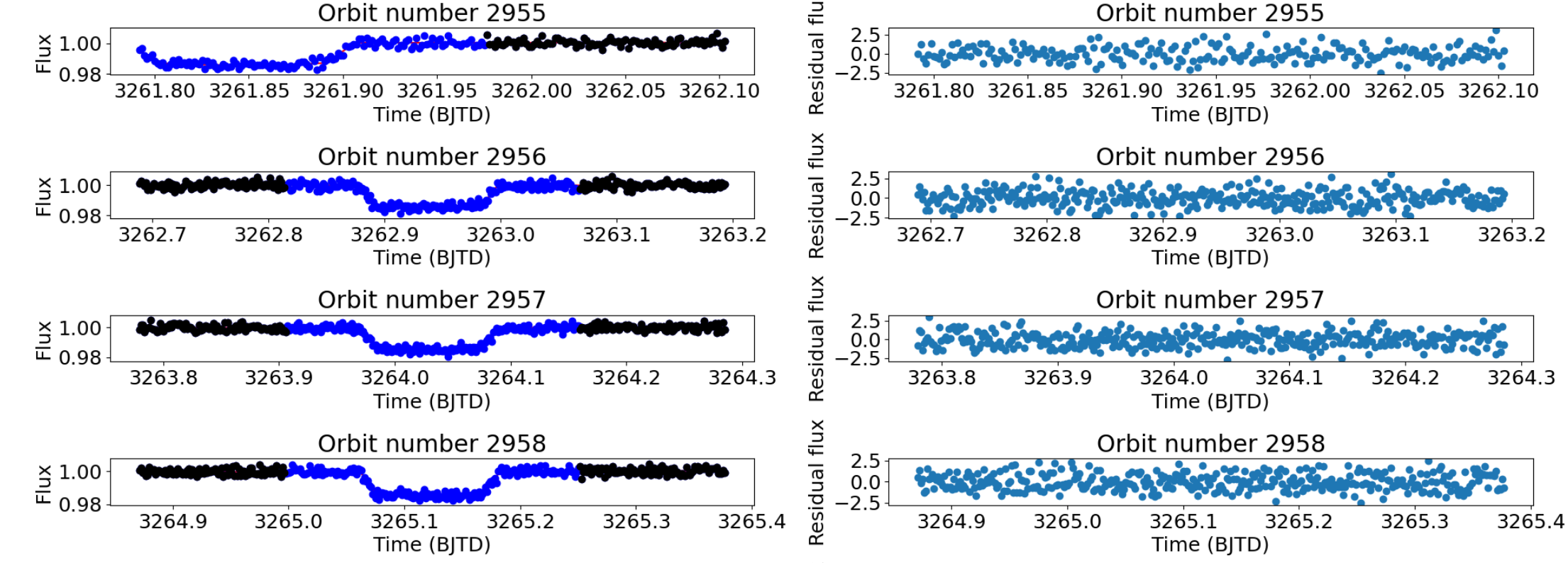
Figure 2: We created a best-fit line for each transit using a minimizer, and we used data from the NASA Exoplanet Archive for needed parameters [16,17]. We then plotted the residual flux against the flux to observe if the orbit data was valid. The figure above only displays four orbital data sets

Figure 3: The transit time deviation of WASP-12b for TESS data sector 72. We compiled the transit time and created a best-fit linear function against the orbit time. We then plotted the transit time deviation for sector 72 data

(a) The best-fit linear function of the orbit number by the transit time

(b) The parabolic transit time deviation by the orbital period with a best-fit linear function after subtracting the calculated times from the observed times
Figure 4: The complete analysis of WASP-12b available transit time data. Data points marked blue were past data organized by ([18] and all credits on the contribution of data of WASP-12). Data marked red were past TESS data that we re-analyzed (TESS, author SPOC data of sectors 20, 43, 44, and 45, with an exposure time of 2 minutes). Data marked green were new TESS data observed in 2023 (author SPOC observed sectors 71 and 72 with 2-minute exposure time)
4.2. WASP-114
WASP-114, located in the constellation Puppis, is an F-type star with a mass approximately 1.29 times that of the Sun. This star is slightly more luminous than our Sun and has been estimated to be around 2.5 billion years old. The star hosts an exoplanet named WASP-114b, classified as a Hot Jupiter. According to the NASA Exoplanet Archive, this planet orbits WASP-114 at a close distance and completes one full orbit in about 1.55 days. [19,20]
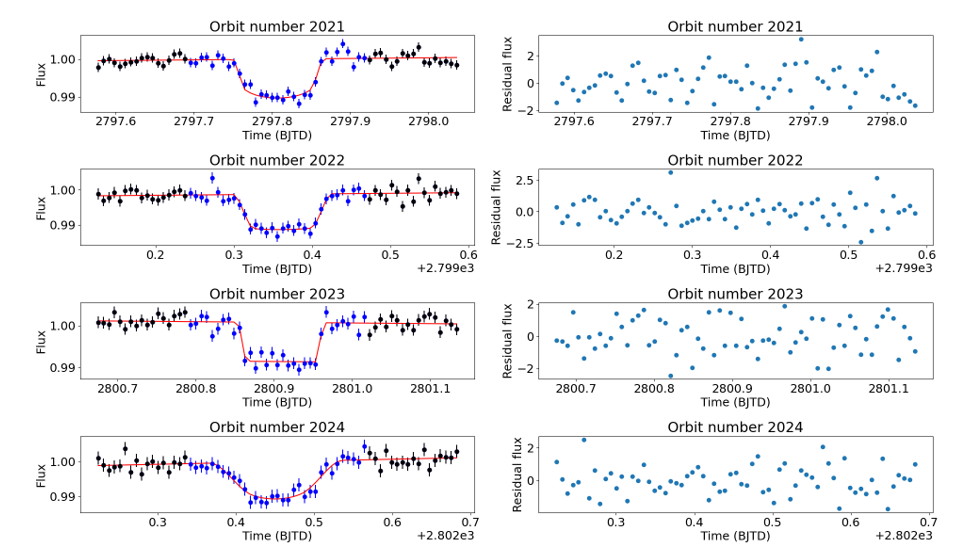
Figure 5: To analyze the characteristics of this exoplanet, especially any orbital decay, we chose to use data from the TESS sector 55, done in 2022. This specific sector was selected due to its medium exposure time of 600, which provided a balance between data quality and the duration of observation, making it an accessible choice for our study. The data processed by the TESS SPOC presented a flux vs time diagram for WASP114
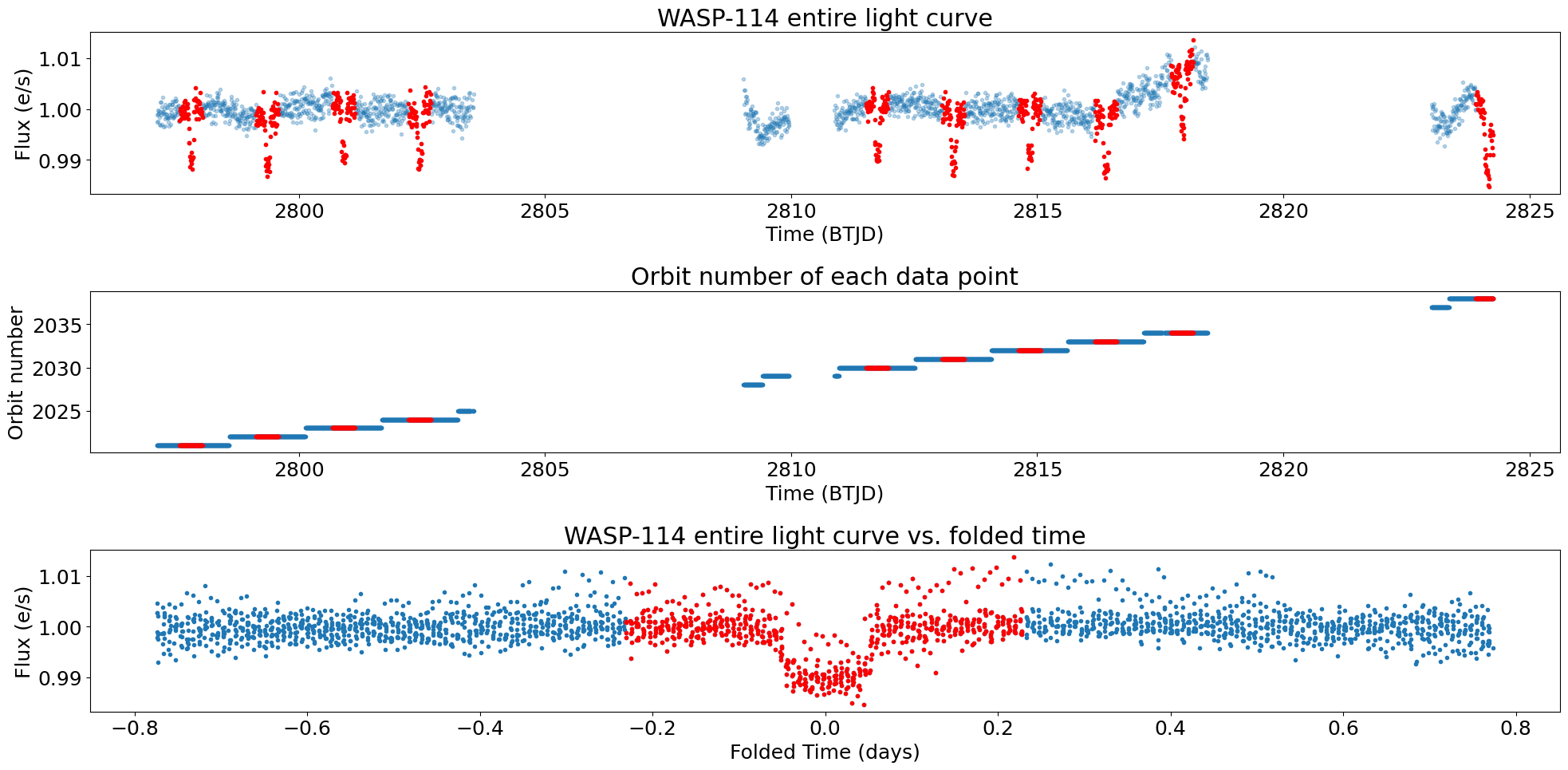
Figure 6: Our analysis combined all available flux curves to create a conclusive picture of WASP114b transits across its host star. We could identify the transit times of WASP-114b by this simple image. The image created from this analysis shows all the transits detected within the dataset. The evidence remains to be seen for the transit deviation image we created using the same model, as there still needs to be more data to draw a clear diagram to illustrate whether WASP114b is decaying. However, it is still essential to know that the results have limitations due to the relative shortage of data from this TESS sector
4.3. WASP-4
WASP4 is a G-type main-sequence star with a mass approximately 1.18 times that of the Sun and a radius of about 1.12 times that of the Sun. The star is located in the Phoenix constellation and is remarkable for hosting the exoplanet WASP-4b, a hot Jupiter. [20,22]

Figure 7: There is a significant number of WASP4 detection and data, so it becomes pretty unnecessary to show all the data graphs in the essay. For our study, we chose to get data from the TESS mission. By combining all of the data from the TESS mission into a single diagram, we can more clearly see the transits and analyze the orbital parameters for WASP4b. After processing and analyzing the data, we tried to fit the transit curves into a model that accounts for various factors, such as the planet's orbital period, the size of the star, and so on. The result of this fitting process is a graph that shows the best fit to the observed transit data. However, it is important to know that while the fit is statistically acceptable, there are still uncertainties and errors in the analysis. The data from TESS can still bring mistakes and errors due to factors such as noise and atmospheric disturbance
4.4. KELT-16b
4.4.1. KELT-16b observations
The KELT-16 is an F-type star, a type of main sequence star. The name Hot Jupiter we are searching for is KELT-16b, and its orbital period is about 0.969 days. Hot Jupiter block partial of its light lasts around 2.489 hours [23].
The following data were collected by the TESS mission 2022, the newest data about the flux of KELT-16. The 55 sector contains KELT-16 data when TESS is working, which has been made with two diagrams, the relative flux of KELT-16 over time diagram and the diagram of folded relative flux of KELT-16 by its period (Figure 8-9).

Figure 8: The relative flux diagram of KELT-16 Data at the sector 55 collected By TESS mission in 2022

Figure 9: The folded KELT-16 Data at sector 55 was collected by the TESS mission in 2022 during the repetitive 0.969-day period of the KELT-16b Hot Jupiter
4.4.2. KELT-16b data analysis

Figure 10: The diagram of all data, including the newest data from TESS and previous scholars about KELT-16, ordered by the orbit number and the mid-transit time

Figure 11: The deviation of each scattered data point in units of minutes with a linear best-fit curve; blue data were from previous scholars, and red data were collected by the TESS mission
The deviation of the scattered data from the linear best-fit curve has a pattern instead of being randomly distributed around zero, which means there might be a decrease in the gradient, which the period as time passes. This observation of the pattern proves the orbital decay, since the period of the hot Jupiter is shrinking, leads to a decrease of the gradient of the line and not as straight as the linear best-fit curve. Moreover, the change of the orbital period derivative to the time \( \dot{P}=-7.32*{10^{-10}}±1.43*{10^{-10}} \) , which also equal to \( \dot{P}=-23.1±9.33 ms/year, \) so the tidal decay factor \( Q_{s}^{ \prime }=3.57*{10^{5}}±1.51*{10^{5}} \) , which close to the theoretical value around 106.
The formula of RV (radial velocity) is shown below (equation 4) [12].
\( \dot{v}=\dot{P}*\frac{c}{P} \) (4)
If further considering the radial velocity of the KELT-16b, it is still suspicious that the orbital is decaying or not since the overall data will still show the same pattern as the orbital decay exists no matter whether the stellar system is moving toward or away from our sight.
The radial velocity \( \dot{v}=-0.226±0.044\frac{m}{s}/day \) (equation 4). The theoretical change of velocity over time is similar to the value from paper [23] about KELT-16 the radial velocity; therefore, the KELT-16 and its hot Jupiter are shifting away from us, and the orbital decay might not cause the suspicious decaying rate, since these two phenomena will show the same pattern of data, so whether the orbit of KELT-16b is decaying or not still needs further confirmation.
4.5. WASP-19b
WASP-19b was one of the first ultrashort period planets discovered. It is a Hot Jupiter in a 0.78-day orbit around a G8V star (WASP-19) located in the constellation Cygnus [24]. WASP-19b has one of the shortest orbital periods for Hot Jupiter, and it has been regarded as a promising target in studying orbital decay. Planets such as WASP-19b are too close to their host star, susceptible to tidal solid interactions, or entirely dominated by their host star. [22] Previous studies reported a weak 3σ period decrease detection [18]. At this stage, if WASP-19 is decaying, then it must be slower than WASP-12b, a Hot Jupiter that had already discovered an orbit decay [13].
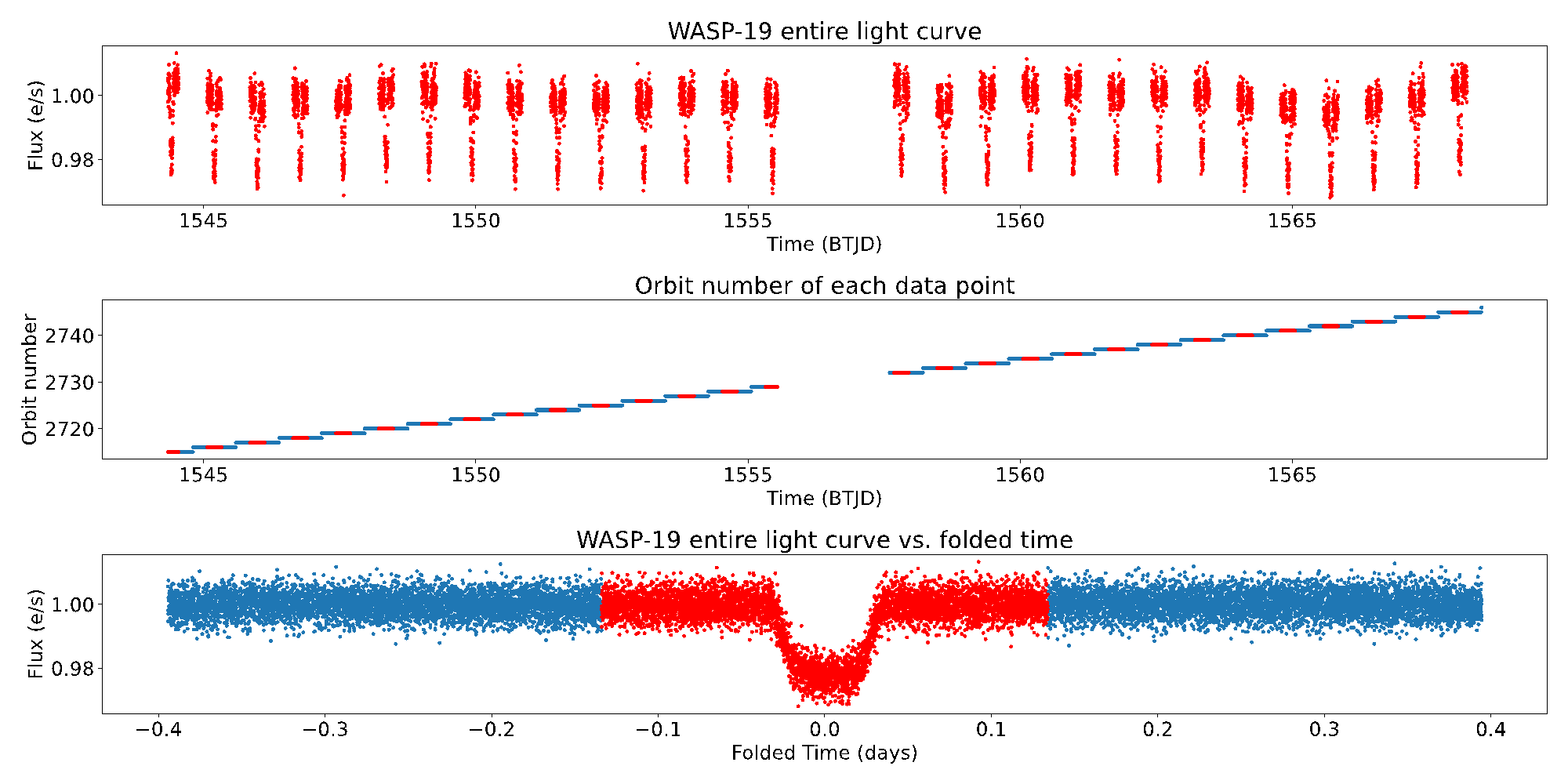
(a) The folded data from the TESS Transit light curve of WASP-19 sector 09, measured in 2019
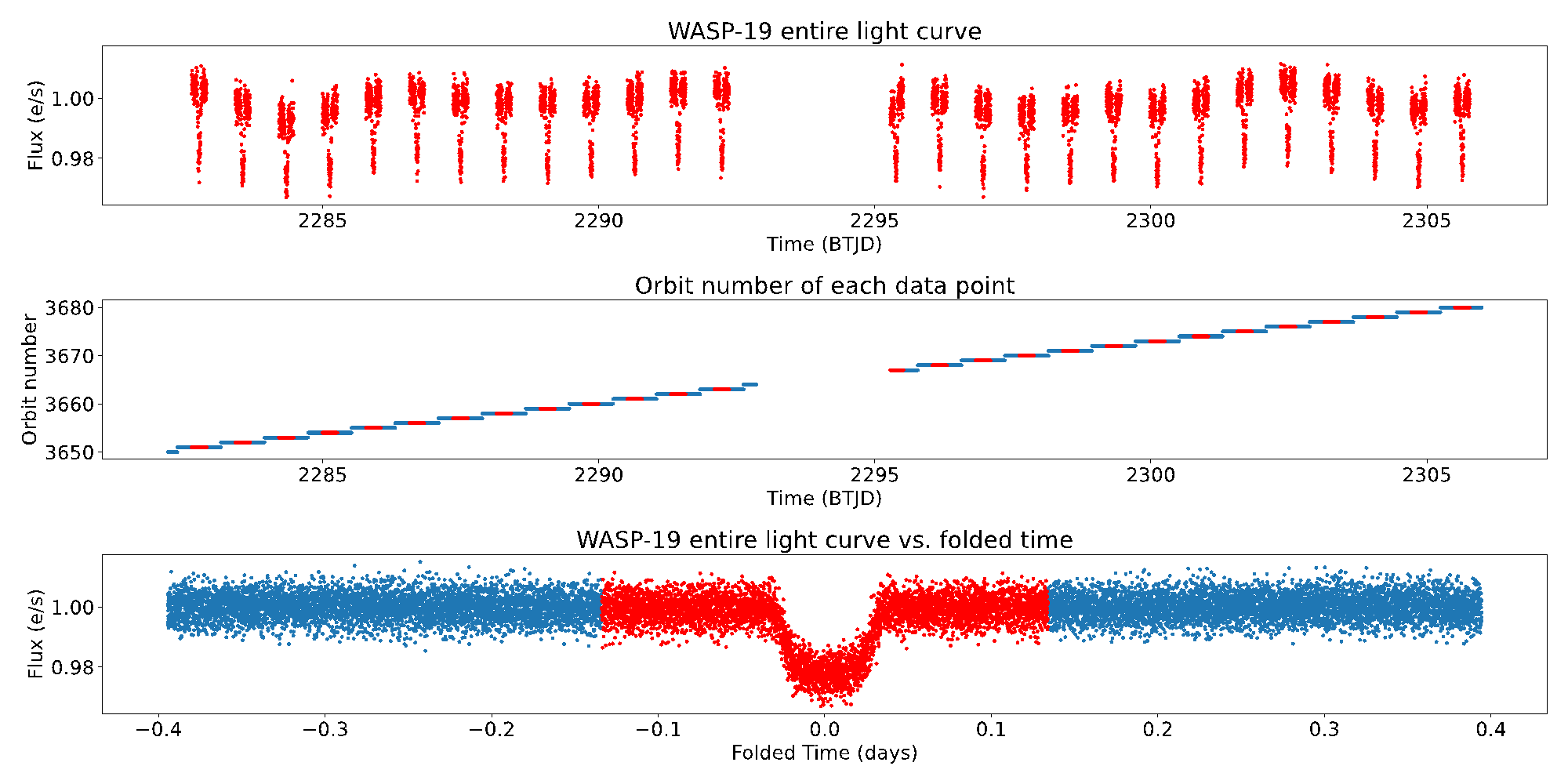
(b) The folded data from the TESS Transit light curve of WASP-19 sector 36, measured in 2021
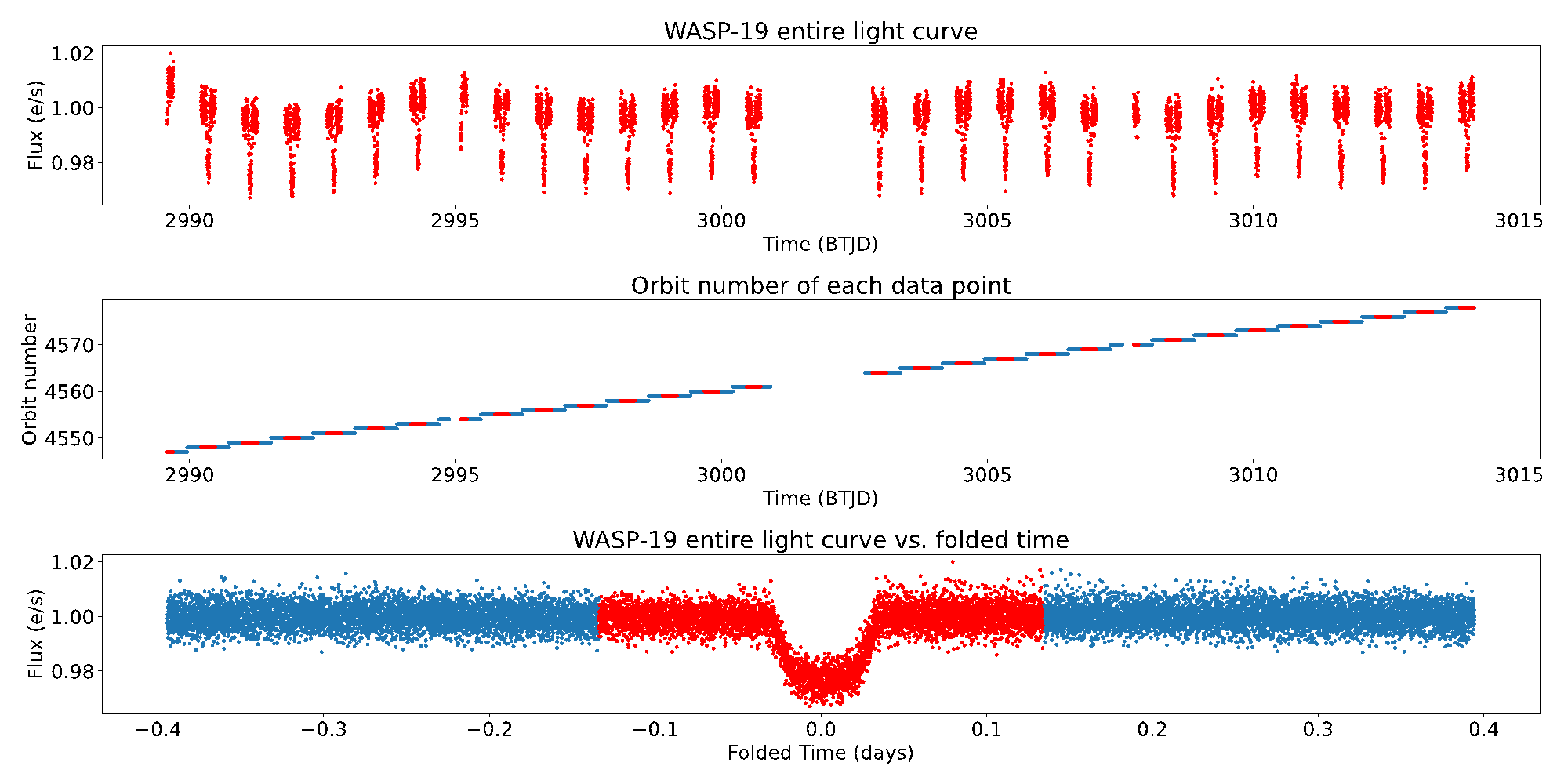
(c) The folded data from the TESS Transit light curve of WASP-19 sector 62, measured in 2023
Figure 12: Folded data sets using TESS light curve scanning
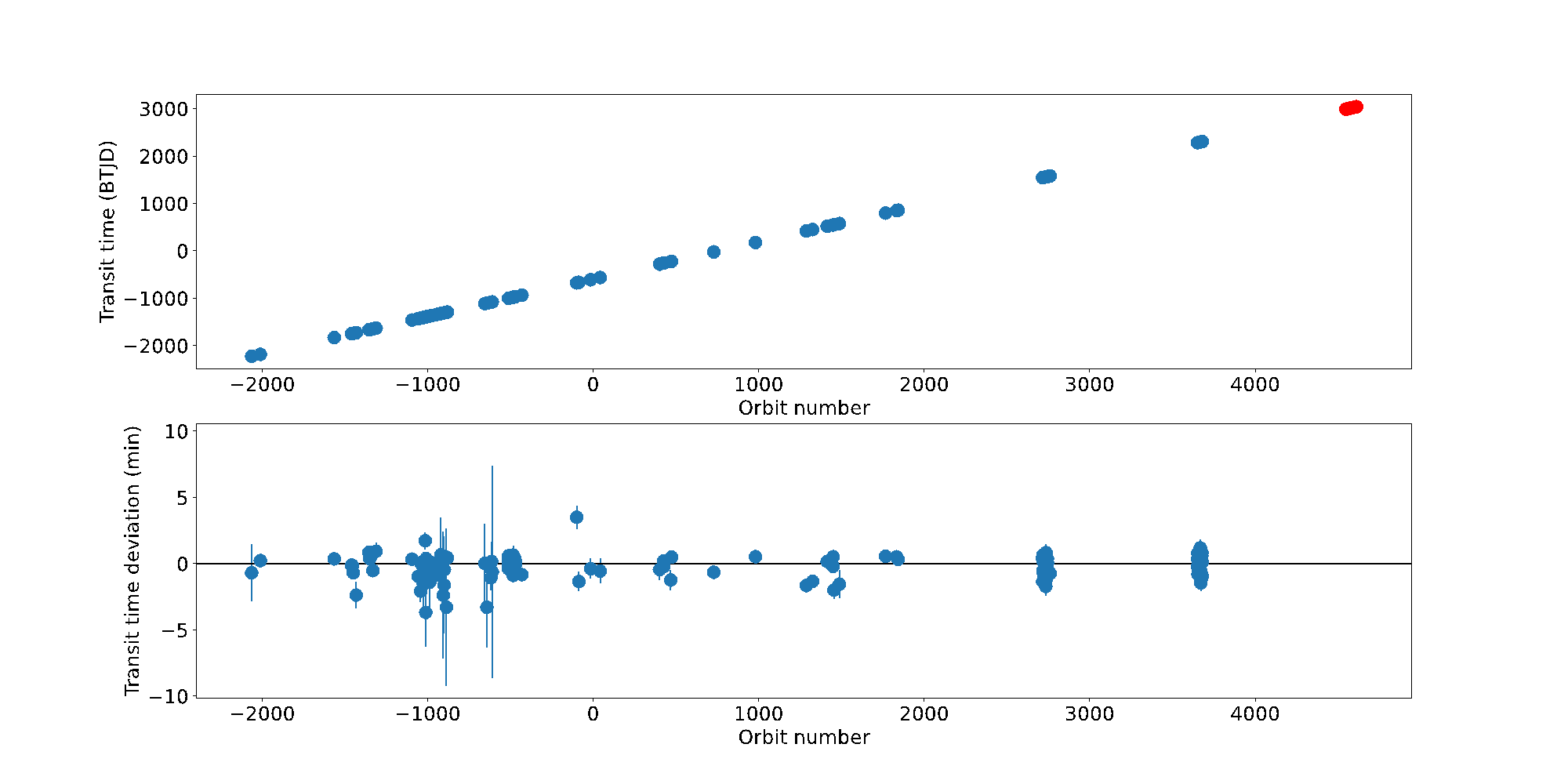
Figure 13: Combined diagram of WASP-19b data, fit to fit linear function best. TESS data sector 09, sector 36, sector 62, and sector 63 are labeled in red; previous data are labeled in blue
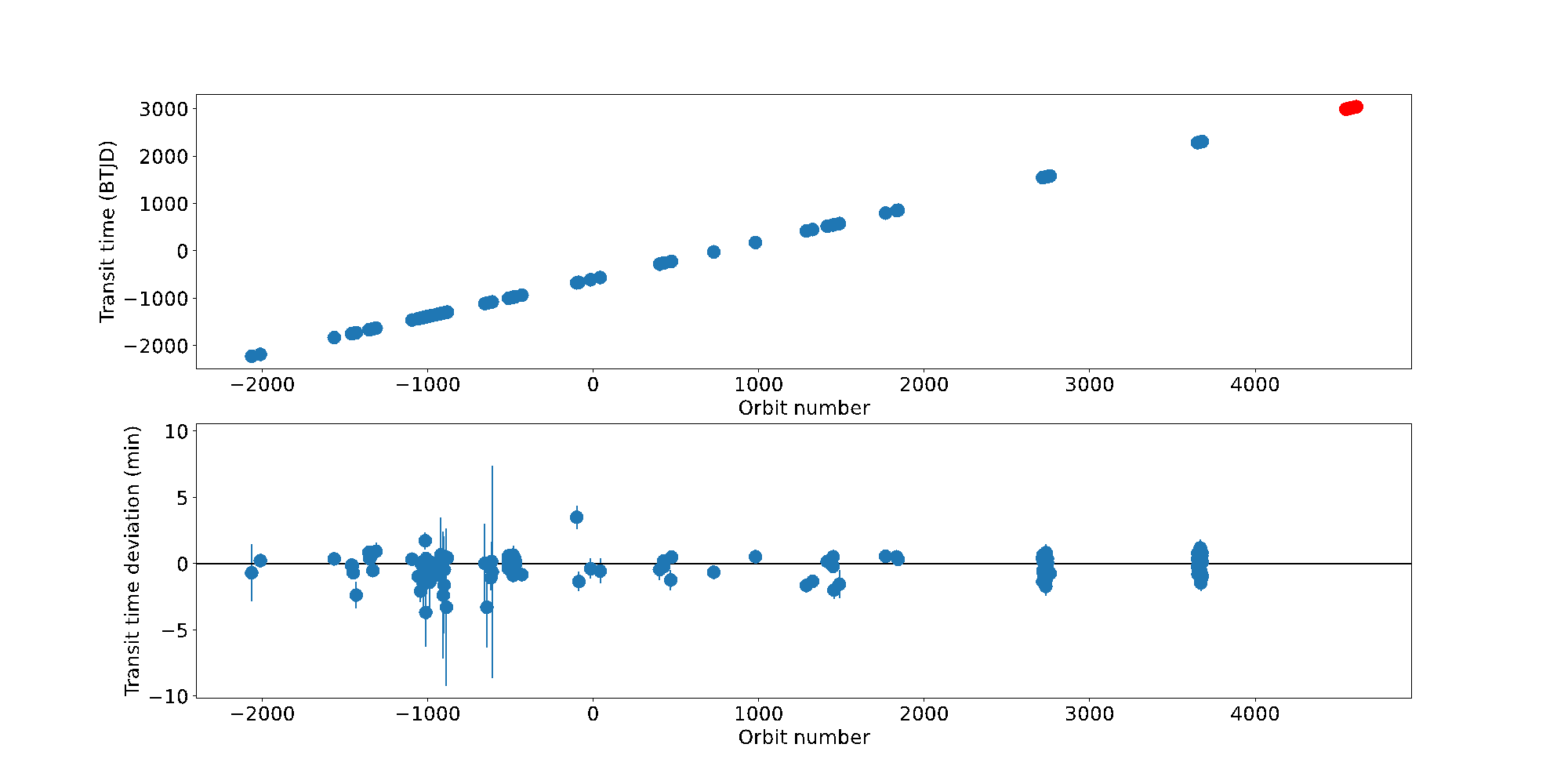
Figure 14: Transit time deviation of each data arranged from the best fit linear data, TESS data sector 09, sector 36, sector 62, and sector 63 are labeled in red, and previous data are labeled in blue
The data on the stellar and planetary properties of the system are from [25]. This work analyzed the newest data from the TESS mission (Transiting Exoplanet Survey Satellite). We combined it with previous data using the database of transit times published by Ivshina & Winn (2022) [15]; with these data (Figure 13 and Figure 14), we found that if the orbital decay is happening for WASP-19, it is still undetectable.
Table 1 The form includes data on the period, modified tidal quality factor, and the decay rate of 5 hot Jupiters (using necessary data from exoplanet achieve [16,17,19-23,26]) that were further researched in this project. Moreover, these factors are essential evidence to prove any possible tidal decay happening on these hot Jupiters.
Table 1: Factors for the scanned Hot Jupiters during this observation
Name of Hot Jupiter observed | Period (day) | \( {Q_{s}} \prime \) | \( \dot{P} \) ( \( \frac{ms}{year} \) ) |
WASP-12 b | 1.09141942 ± 0.00000003 | 219593.46 ± 46949.49 | -29.953491 ± 1.017937 |
WASP-4 b | 1.33823138 ± 0.00000003 | \( \gt \) 34641.47 ± 9284.02 | -9.361020 ± 1.276553 |
WASP-19 b | 0.78883919 ± 0.00000003 | \( \gt \) 600787.73 ± 142737.03 | -4.616457 ± 0.790308 |
WASP-114 b | 1.54877953 ± 0.00000244 | \( \gt \) 15266.27 ± 8315.25 | -95.133574 ± 51.293646 |
KELT-16 b | 0.96899375 ± 0.00000042 | \( \gt \) 357161.91 ± 51220.15 | -23.085302 ± 9.333312 |
5. Conclusion
Based on the study results and discussion we have made above (see Table 1 for calculated results), the conclusions are obtained as below:
1. Research and discussions by ourselves proved some orbital decaying events happen on some of the exoplanets we have discussed, including WASP12 with definite orbital decay evidence and KELT16 with a small quantity of uncertainty due to a lack of observed data and technical calculations. The rest of the stars we discussed are considered as only possible, and the rest of our WASP stars discussed seem to have massive uncertainty because of our technical limits.
2. Most of our data refers to the NASA Exoplanetary Archive. If data in the archive has errors, some parts of our research can be wrong. However, tiny errors due to force majeure factors such as atmospheric disturbance have been taken into account by statistic methods, as we proved the errors of data fit the model created.
3. The research can be better by improving some factors. We recommend that TESS collect more practical and accurate data for some of our researched targets, which might improve the result, especially for WASP-114 and KELT-16, which have more uncertainty due to the lack of observed data.
Acknowledgments
We are grateful to the CIS staff and Shanghai Jiao Tong University (Qibao Campus) for hosting this program and conducting research on exoplanetary science. We also appreciate Professor Joshua Winn and teaching assistants for technical support.
Statement of work
Contributions to the paper were organized as follows. Naomi covers the abstract, introduction, and analysis of WASP-12 and the summarization table in the conclusion section. Mark discussed the target selection and method section, wrote the analysis of KELT-16, and illustrated the table in the conclusion. Justin described the analysis of WASP-114 and WASP-4, concluding the entire paper. Helen reports the analysis of WASP-19.
References
[1]. Rebekah I. D., John Asher Johnson. (2018) Annual Review of Astronomy and Astrophysics Vol.56:175-221
[2]. Mayor, M., Queloz, D. (1995) Nature, Volume 378, Issue 6555, pp. 355-359 (1995).
[3]. Ogilvie, Gordon I. (2014) Annual Review of Astronomy and Astrophysics, vol. 52, p.171-210.
[4]. Rasio, F. A. Tout, C. A. Lubow, S. H. Livio, M. (1996) Astrophysical Journal v.470, p.1187
[5]. Winn, J. N. (2010) Exoplanets, edited by S. Seager. Published by University of Arizona Press, Tucson, AZ, 2010, 526 pp. ISBN 978-0-8165-2945-2., p.55-77.
[6]. Barker, Adrian J. Ogilvie, Gordon I. (2010) Monthly Notices of the Royal Astronomical Society, Volume 404, Issue 4, pp. 1849-1868.
[7]. Barker, Adrian J. Ogilvie, Gordon I. (2009) Monthly Notices of the Royal Astronomical Society, Volume 395, Issue 4, pp. 2268-2287.
[8]. Jackson, B. Greenberg, R. Barnes, R. (2008) The Astrophysical Journal, Volume 678, Issue 2, pp. 1396-1406.
[9]. Jackson, Brian Barnes, Rory Greenberg, Richard (2009) The Astrophysical Journal, Volume 698, Issue 2, pp. 1357-1366.
[10]. Yee, Samuel W. Winn, Joshua N. (2020) The Astrophysical Journal Letters, Volume 888, Issue 1, article id. L5, 11 pp.
[11]. Hebb, L.; Collier-Cameron, A. (2009) The Astrophysical Journal, Volume 693, Issue 2, pp. 1920-1928.
[12]. Maciejewski, G. Dimitrov, D. (2016) Astronomy & Astrophysics, Volume 588, id. L6, 6 pp.
[13]. Patra, Kishore C. Winn, Joshua N.; (2017) The Astronomical Journal, Volume 154, Issue 1, article id. 4, 10 pp.
[14]. Patra, Kishore C. Winn, Joshua N. (2020)The Astronomical Journal, Volume 159, Issue 4, id.150, 15 pp.
[15]. Rosário, N. M., Barros, S. C. C., Demangeon, O. D. S., & Santos, N. C. (2022). Measuring the orbit shrinkage rate of hot Jupiters due to tides. Astronomy & Astrophysics, 668, A114.
[16]. Chakrabarty, A. Sengupta, S. (2019) The Astronomical Journal, Volume 158, Issue 1, article id. 39, 17 pp.
[17]. Kokori, A. Tsiaras, A. (2023) The Astrophysical Journal Supplement Series, Volume 265, Issue 1, id.4, 20 pp.
[18]. Ivshina, Ekaterina S. Winn, Joshua N. (2022) The Astrophysical Journal Supplement Series, Volume 259, Issue 2, id.62, 19 pp
[19]. Stassun, Keivan G. Oelkers, Ryan J. (2019) The Astronomical Journal, Volume 158, Issue 4, article id. 138, 21 pp.
[20]. Bouma, L. G. Winn, J. N (2019) The Astronomical Journal, Volume 157, Issue 6, article id. 217, 16 pp.
[21]. Barros, S. C. C. Brown, D. J. A. (2016) Astronomy & Astrophysics, Volume 593, id.A113, 9 pp.
[22]. Levrard B, Winisdoerffer C, Chabrier G (2009) The Astrophysical Journal 692
[23]. Thomas E. Oberst, Joseph E. Rodriguez et al. (2017). KELT-16b: A Highly Irradiated, Ultra short Period Hot Jupiter Nearing Tidal Disruption. The Astronomical Journal, 153(97), 1-18
[24]. Hebb L, Collier-Cameron A. (2010) The Astrophysical Journal, Volume 708, Issue 1, pp. 224-231
[25]. Cortes-Zuleta P, Rojo P, Wang S, Hinse T C, Hoyer S, Sanhueza B, Correa-Amaro P, Albornoz J (2020) Astronomy & Astrophysics 636
[26]. Kokori, A. Tsiaras, A. (2023) The Astrophysical Journal Supplement Series, Volume 265, Issue 1, id.4, 20 pp.
Cite this article
Shan,S.;Bai,Z.;Pan,J. (2025). Finding the Newest Evidence of Orbital Decay in Hot Jupiters. Theoretical and Natural Science,107,135-146.
Data availability
The datasets used and/or analyzed during the current study will be available from the authors upon reasonable request.
Disclaimer/Publisher's Note
The statements, opinions and data contained in all publications are solely those of the individual author(s) and contributor(s) and not of EWA Publishing and/or the editor(s). EWA Publishing and/or the editor(s) disclaim responsibility for any injury to people or property resulting from any ideas, methods, instructions or products referred to in the content.
About volume
Volume title: Proceedings of the 4th International Conference on Computing Innovation and Applied Physics
© 2024 by the author(s). Licensee EWA Publishing, Oxford, UK. This article is an open access article distributed under the terms and
conditions of the Creative Commons Attribution (CC BY) license. Authors who
publish this series agree to the following terms:
1. Authors retain copyright and grant the series right of first publication with the work simultaneously licensed under a Creative Commons
Attribution License that allows others to share the work with an acknowledgment of the work's authorship and initial publication in this
series.
2. Authors are able to enter into separate, additional contractual arrangements for the non-exclusive distribution of the series's published
version of the work (e.g., post it to an institutional repository or publish it in a book), with an acknowledgment of its initial
publication in this series.
3. Authors are permitted and encouraged to post their work online (e.g., in institutional repositories or on their website) prior to and
during the submission process, as it can lead to productive exchanges, as well as earlier and greater citation of published work (See
Open access policy for details).
References
[1]. Rebekah I. D., John Asher Johnson. (2018) Annual Review of Astronomy and Astrophysics Vol.56:175-221
[2]. Mayor, M., Queloz, D. (1995) Nature, Volume 378, Issue 6555, pp. 355-359 (1995).
[3]. Ogilvie, Gordon I. (2014) Annual Review of Astronomy and Astrophysics, vol. 52, p.171-210.
[4]. Rasio, F. A. Tout, C. A. Lubow, S. H. Livio, M. (1996) Astrophysical Journal v.470, p.1187
[5]. Winn, J. N. (2010) Exoplanets, edited by S. Seager. Published by University of Arizona Press, Tucson, AZ, 2010, 526 pp. ISBN 978-0-8165-2945-2., p.55-77.
[6]. Barker, Adrian J. Ogilvie, Gordon I. (2010) Monthly Notices of the Royal Astronomical Society, Volume 404, Issue 4, pp. 1849-1868.
[7]. Barker, Adrian J. Ogilvie, Gordon I. (2009) Monthly Notices of the Royal Astronomical Society, Volume 395, Issue 4, pp. 2268-2287.
[8]. Jackson, B. Greenberg, R. Barnes, R. (2008) The Astrophysical Journal, Volume 678, Issue 2, pp. 1396-1406.
[9]. Jackson, Brian Barnes, Rory Greenberg, Richard (2009) The Astrophysical Journal, Volume 698, Issue 2, pp. 1357-1366.
[10]. Yee, Samuel W. Winn, Joshua N. (2020) The Astrophysical Journal Letters, Volume 888, Issue 1, article id. L5, 11 pp.
[11]. Hebb, L.; Collier-Cameron, A. (2009) The Astrophysical Journal, Volume 693, Issue 2, pp. 1920-1928.
[12]. Maciejewski, G. Dimitrov, D. (2016) Astronomy & Astrophysics, Volume 588, id. L6, 6 pp.
[13]. Patra, Kishore C. Winn, Joshua N.; (2017) The Astronomical Journal, Volume 154, Issue 1, article id. 4, 10 pp.
[14]. Patra, Kishore C. Winn, Joshua N. (2020)The Astronomical Journal, Volume 159, Issue 4, id.150, 15 pp.
[15]. Rosário, N. M., Barros, S. C. C., Demangeon, O. D. S., & Santos, N. C. (2022). Measuring the orbit shrinkage rate of hot Jupiters due to tides. Astronomy & Astrophysics, 668, A114.
[16]. Chakrabarty, A. Sengupta, S. (2019) The Astronomical Journal, Volume 158, Issue 1, article id. 39, 17 pp.
[17]. Kokori, A. Tsiaras, A. (2023) The Astrophysical Journal Supplement Series, Volume 265, Issue 1, id.4, 20 pp.
[18]. Ivshina, Ekaterina S. Winn, Joshua N. (2022) The Astrophysical Journal Supplement Series, Volume 259, Issue 2, id.62, 19 pp
[19]. Stassun, Keivan G. Oelkers, Ryan J. (2019) The Astronomical Journal, Volume 158, Issue 4, article id. 138, 21 pp.
[20]. Bouma, L. G. Winn, J. N (2019) The Astronomical Journal, Volume 157, Issue 6, article id. 217, 16 pp.
[21]. Barros, S. C. C. Brown, D. J. A. (2016) Astronomy & Astrophysics, Volume 593, id.A113, 9 pp.
[22]. Levrard B, Winisdoerffer C, Chabrier G (2009) The Astrophysical Journal 692
[23]. Thomas E. Oberst, Joseph E. Rodriguez et al. (2017). KELT-16b: A Highly Irradiated, Ultra short Period Hot Jupiter Nearing Tidal Disruption. The Astronomical Journal, 153(97), 1-18
[24]. Hebb L, Collier-Cameron A. (2010) The Astrophysical Journal, Volume 708, Issue 1, pp. 224-231
[25]. Cortes-Zuleta P, Rojo P, Wang S, Hinse T C, Hoyer S, Sanhueza B, Correa-Amaro P, Albornoz J (2020) Astronomy & Astrophysics 636
[26]. Kokori, A. Tsiaras, A. (2023) The Astrophysical Journal Supplement Series, Volume 265, Issue 1, id.4, 20 pp.





